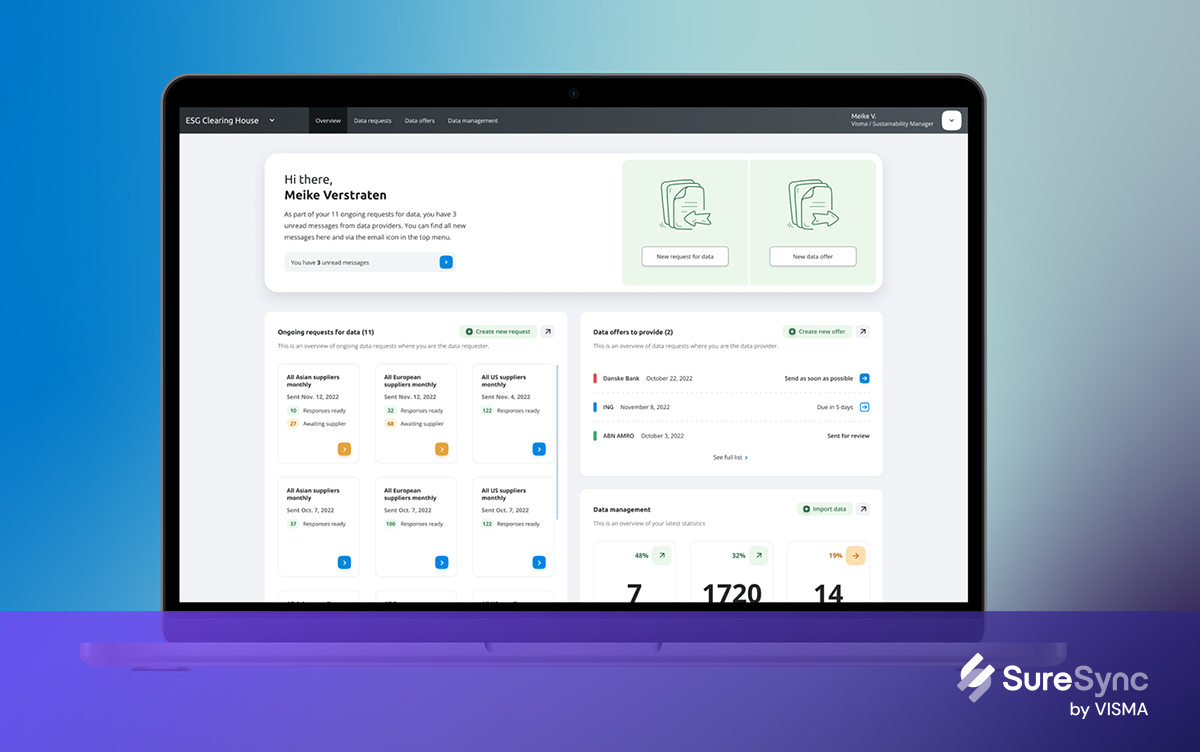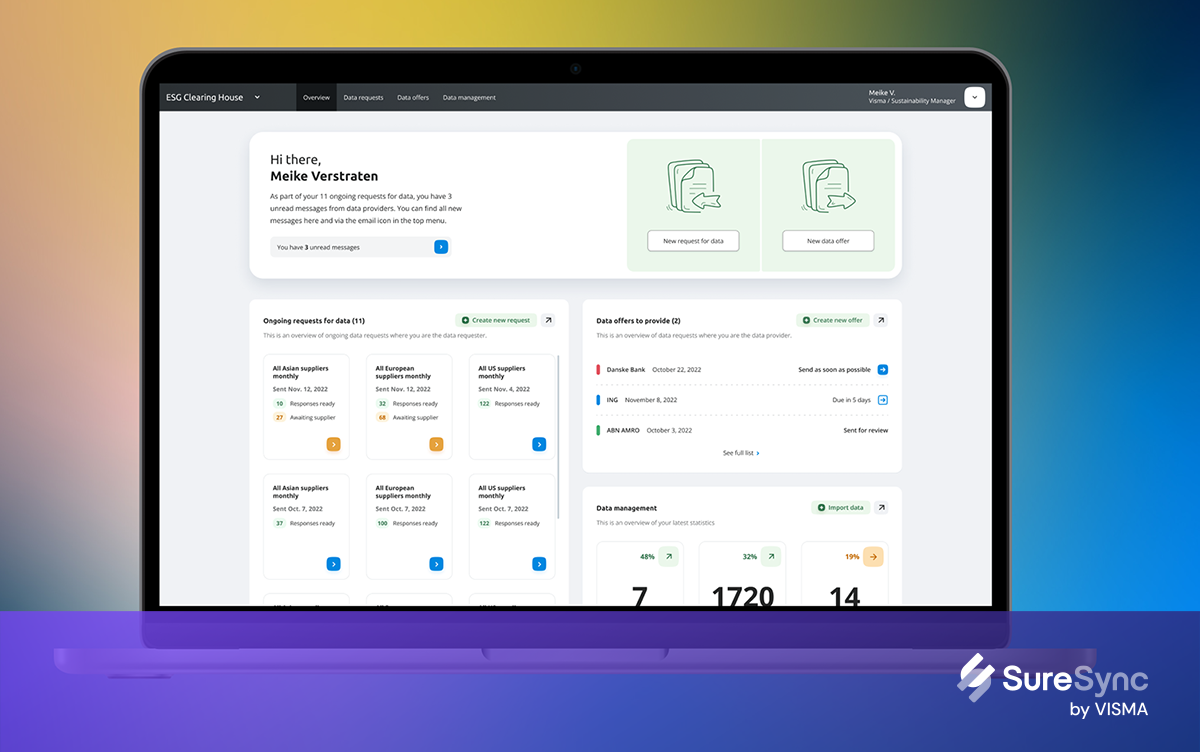How the ESG Clearing House will transform sustainability reporting for the finance sector
Financial institutions are no strangers to the use of data when it comes to risk management and compliance. Sustainability disclosure requirements compel financial institutions to expand the use of data for sustainability reporting and evaluating climate-related risks. This increases the demand for high-quality, granular ESG data.
In this blog
- How the ESG Clearing House supports financial services companies
- How does the ESG Clearing House improve sustainability data reporting?
- Join the ESG Clearing House for future-proof sustainability reporting
Further reading below 👇
To meet this growing demand for standardised, auditable, automated and secured ESG data, the market needs an exchange place to relieve financial institutions' and clients' reporting burden.
This is where the ESG Clearing House comes in. Founded by Visma Connect, Signify and ABN AMRO, the ESG Clearing House is a global, non-profit solution to enable all participants, to exchange sustainability data through a common solution in a standardised format. It operates on a peer-to-peer, metric-by-metric basis using battle-proven technology to reliably and securely exchange millions of sustainability data transactions every month.
This blog breaks down how the ESG Clearing House can benefit companies’ sustainability reporting and why standardised data reporting is needed for financial services companies like ABN AMRO.
Join Solving the ESG Data Challenge
ESG Clearing House founders ABN AMRO, Signify, and Visma invite you to join their webinar: Solving the ESG Data Challenge.

In this webinar, we'll explore
- the need for a standardised ESG data exchange
- how to improve ESG data quality: comparable, reliable, complete
- a solution for the collection and exchange of ESG data
How the ESG Clearing House supports financial services companies
Data sourcing for the relevant ESG information takes a lot of time from the financial sector and capital providers. For instance, about 95% of the sector’s total CO2 impact is in its scope 3 emissions. This means it is produced by suppliers and customers and therefore most of the time not readily accessible in-house.
The newly adopted CSRD requires even more granular and better data on clients, loans and other financial products. A typical bank can have hundreds of thousands of corporate clients, and each will have to provide many individual data points.
For this reason, ABN AMRO co-started the ESG Clearing House initiative. This ESG Clearing House initiative focuses on getting better quality and more granular data and sharing that data in an accessible platform. The ESG Clearing House has a broad and robust governance framework to meet regulatory requirements. A common challenge that capital providers face with their clients is that there are numerous data requests, often with more than one party asking for sustainability data. Besides the other companies in their value chain, this includes rating agencies and other stakeholders.
That’s where the ESG Clearing House can help. With the ESG Clearing House initiative, standardised data can be reported along the entire value chain of a company. Using the standard XRBL format there is a common language for all data entry that ensures consistency and transparency and improves the data quality. All data sources from suppliers will be included, and emissions data will be available upon request without having to individually reach out to various contacts along the value chain.
The ESG Clearing House can exchange metrics from large numbers of clients and functions as a multiple-access data exchange this is especially important for the financial services sector. This means data can be made available to stakeholders, investors, and capital providers.
The ESG Clearing House has been founded collaboratively, with a number of core principles underpinning its direction:
- Common, inclusive and neutral
- Open partnership, shared benefits, but not for free
- Sharing fees between preparers and users
- A broad oversight body governs the ESG Clearing House
- Public accountability and transparency
- Entrepreneurial, hands-on and agile approach
- Data preparers will always own their data
The most important on this list is the data preparers owning their data. The ESG Clearing House will never sell data. The responsibility for the (company-related) content always lies with the data owner/providers.
How does the ESG Clearing House improve sustainability data reporting?
Incorporating improved ESG reporting into financial services reporting can help achieve greater social and environmental impact with financial products and improve the institution’s reputation. Robust ESG reporting forms the foundation for a transparent plan that focuses on helping the environment, supporting diversity and equal opportunities, and ensuring ethical business decisions.
Research by Deloitte found that at their current growth rate, ESG-mandated assets are on track to represent half of all professionally managed assets globally by 2024. The ESG Clearing House presents a streamlined framework for sustainability data reporting that can prepare financial institutions to demonstrate their ESG impact.
The ESG Clearing House enables a completely market-led exchange of ESG data. Today, there are lots of ESG reporting tools or data available from ESG data providers. None of these is functioning as a truly centralised data exchange. The ESG clearing house can deliver exactly that. The ESG Clearing House can also help reporters understand the type of data required for their reporting and how best it can be presented.
Although the ESG Clearing House is a non-profit initiative, it will not be free. It is all about sharing the benefits. There will be a fee for participants, but considering the collaborative nature of the project, the more participants are involved, the smaller this fee will be. More participants also reduce the number of points of contact for data collection, and it helps make the ESG Clearing House a single point-of-access of ESG data directly from the source.
Join the ESG Clearing House for future-proof sustainability reporting
There is an increasing focus on, and demand for, the exchange of standardised, reliable, sustainability data throughout the supply chain, from companies to financial products.
Through the ESG Clearing House, sustainability data quality will be on an equal footing as financial data regarding how it is used, its distribution and reliability. Parties can draw on the ESG Clearing House to get their data. This will in turn relieve some of the reporting burdens that companies feel.
As a global financial services company, ABN AMRO is now actively trying to recruit peers in the finance sector, for the initiative, with the clear objective in the near-term future of securing funding to build the ESG Clearing House software.
In this initial stage of piloting, a group of 20 to 30 companies will be involved, during which the ESG Clearing House will further develop its governance model.
This is the beginning of an exciting new chapter that will transform ESG data reporting for capital providers. Any financial institution involved at this early stage can take a leading role in shaping the initiative and its direction.
For more information about the ESG Clearing House, request our letter of interest to indicate your interest in joining the initiative; please visit the ESG Clearing House website.




